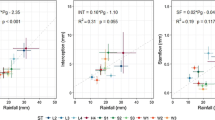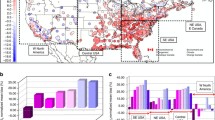Abstract
This paper presents a model of water flux and throughfall concentrations of K+ and NH +4 in a subalpine balsam fir forest. The model is based on a multi-layer submodel of hydrologic flow. Cloud water deposition and evaporation are incorporated as separate submodels. Chemical exchange is parameterized with diffusion resistances and internal foliar concentrations determined from leaching experiments on isolated canopy components. The model is tested against within-storm throughfall measurements and found to agree reasonably well in most instances. Some specific departures from observed data are noted, of which some can be explained. Differences between observed and modeled concentrations of K+ early in the storm events suggest that pre-storm conditions, which were not modeled, are important in controlling the chemical exchange.
Responses of throughfall chemistry to changes in rain rate, rain concentration, and stand surface area index (SAI) were investigated by simulation with the model. Increasing rain rates increased leaching of K+ and uptake of NH +4 . Increasing concentrations of K+ in rain decreased slightly the amount of K+ leached, but increasing concentration of NH +4 in rain increased NH +4 uptake proportionately. Increasing canopy SAI increased the leaching of K+ and the uptake of NH +4 , with the pattern of the increase dependent on rain rate.
Similar content being viewed by others
References
Chen CW, Hudson RJM, Gherini SF, Dean JD & Goldstein RA (1983) Acid rain model: canopy module. J. Environ. Eng. 109: 585–603
Cronan CS (1980) Solution chemistry of a New Hampshire subalpine ecosystem: a biogeochemical analysis. Oikos 43: 272–281
Hamilton RJ, McCann AW & Sewell PA (1982) Foliar uptake of wild oat herbicide flampropmethyl by wheat. In: Cutler DF, Alvin KL & Price CE (Eds) The Plant Cuticle (pp 303–313) Academic Press, London
Johannes AJ, Chen YL, Dackson K & Suleski T (1986) Modeling of throughfall chemistry and indirect measurement of dry deposition. Water Air Soil Poll. 30: 211–216
Landsberg JJ & Thom AS (1971) Aerodynamic properties of a plant of complex structure. Q. J. Roy. Met. Soc. 97: 565–570
Lang GE, Reiners WA & Heier RK (1976) Potential alteration of precipitation chemistry by epiphytic lichens. Oecologia 25: 229–241
Lang GE, Reiners WA & Pike LH (1980) Structure and biomass dynamics of epiphytic lichen communities of balsam fir forests in New Hampshire. Ecology 61: 541–550
Lindberg SE, Lovett GM, Richter DD & Johnson DW (1986) Atmospheric deposition and canopy interactions of major ions in a forest. Science 231: 93–192
Lovett GM (1981) Forest structure and atmospheric interactions: predictive models for subalpine balsam fir forests. Ph.D. thesis, Dartmouth College, Hanover, NH. 225 p
Lovett GM (1984) Rates and mechanisms of cloud water deposition to a subalpine balsam fir forest. Atmospheric Environment 18: 361–371
Lovett GM, Reiners WA & Olson RK (1982) Cloud droplet deposition in subalpine balsam fir forests: hydrological and chemical inputs. Science 218: 1303–1304
Lovett GM & Reiners WA (1986) Canopy structure and cloud water deposition in subalpine coniferous forests. Tellus 38B: 319–327
Luxmoore RJ, Begovich CL & Dixon KR (1978) Modeling solute uptake and incorporation into vegetation and litter. Ecological Modeling 5: 137–171
McFarlane JC & Berry WL (1974) Cation penetration through isolated leaf cuticles. Plant Physiol. 53: 723–727
Olson RK, Reiners WA, Cronan CS & Lang GE (1981) The chemistry and flux of throughfall and stemflow in subalpine balsam fir forests. Holarctic Ecology 4: 291–300
Olson RK, Reiners WA & Lovett GM (1985) Trajectory analysis of forest canopy effects on chemical flux in throughfall. Biogeochemistry 1: 361–373
Parker GG (1983) Throughfall and stemflow in the forest nutrient cycle. Advances in Ecological Research 13: 57–133
Price CE (1982) A review of the factors influencing the penetration of pesticides through plant leaves. In: Cutler DF, Alvin KL & Price CE (Eds) The Plant Cuticle (pp 237–252) Academic Press, London
Reiners WA & Lang GE (1979) Vegetational patterns and processes in the balsam fir zone, White Mountains, New Hampshire. Ecology 60: 403–417
Reiners WA & Olson RK (1984) Effects of canopy components on throughfall chemistry: an experimental analysis. Oecologia 63: 320–330
Reiners WA, Olson RK, Howard L & Schaefer DA (1986) Ion migration from interiors to outer surfaces of balsam fir needles during dry, interstorm periods. Envir. and Exp. Bot. 26: 227–231
Reiners WA, Lovett GM & Olson RK (1987) Chemical interactions of a forest canopy with the atmosphere. In: Moses H, Mohnen V & Slade DH (Eds) Proceedings of the Forest-Atmosphere Interaction Workshop (pp 111–146) U.S. Dept. of Energy, Office of Energy Res. CONF-85-10250, UC-5, 11. Washington, DC
Rutter AJ, Kershaw KA, Robins PC & Morton AJ (1971) A predictive model of rainfall interception in forests. 1. Derivation of the model from observations in a plantation of Corsican pine. Agricultural Meteorology 9: 367–384
Schaefer DA, Reiners WA & Olson RK (1988) Factors controlling the chemical alteration of throughfall in a subalpine balsam fir canopy. Envir. and Exp. Bot. 28: 175–189
Thorne PG, Lovett GM & Reiners WA (1982) Experimental determination of droplet impaction on canopy components of balsam fir. J. Appl. Meteorol. 21: 1413–1416
Tyree MT & Jarvis PG (1982) Water in tissues and cells. In: Lange OL, Nobel PS, Osmond CB & Ziegler H (Eds) Encyclopedia of Plant Physiology: Physiological Plant Ecology, New Series Vol. 12B (pp 35–77) Springer-Verlag, Berlin
Author information
Authors and Affiliations
Rights and permissions
About this article
Cite this article
Lovett, G.M., Reiners, W.A. & Olson, R.K. Factors controlling throughfall chemistry in a balsam fir canopy: A modeling approach. Biogeochemistry 8, 239–264 (1989). https://doi.org/10.1007/BF00002891
Issue Date:
DOI: https://doi.org/10.1007/BF00002891




